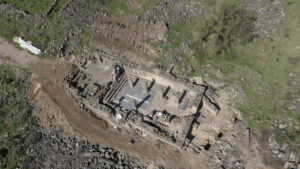Today, more than 30 ancient synagogues have been discovered in the Golan. Synagogues originated in Babylonia or in the Land of Israel during the Second Temple Period (apparently during Hasmonean Rule). Initially, synagogues were community centers, mainly for the reading and studying of the Torah, but also for other community gatherings. During the Second Temple Period, there were no permanent prayers like today (i.e., the morning, afternoon, and evening prayers), and synagogues were actually not used for prayer.
It was here in the Golan that the synagogue of Gamla was discovered; it was built during the Second Temple Period, and was destroyed during the Great Revolt against the Romans.
Recently, a synagogue was discovered at Majdulia (near Moshav Natur), which is from the Roman Period. All the other ancient synagogues in the Golan date to the Byzantine Period, and the beginning of the Early Islamic Period (4th to 8th centuries CE). The ancient Golan synagogues were built in the center of the ancient villages as an integral part of the community. They were spiritual centers as well as community centers for the local Jewish population of the Golan.
The synagogues were built from basalt stones. The internal walls were covered with white plaster. These were impressive buildings that rose to a height of two stories, and were covered with tiled rooftops.




It is known from archaeological excavations that the ancient communities invested large sums of money to build these magnificent synagogues; they were much fancier than their own private homes. The Golan synagogues were decorated with stone engravings; the most outstanding ones are of a Menorah, a Shofar, the Four Kinds, an Incense Shovel (used in the Temple in Jerusalem for ritual purposes), as well as lions and vultures. The decorations inspired by the Temple are evidence of the great yearning that these Jews had for its rebuilding, even 500 years after its destruction. Concerning the engraving of animals: could they be symbols of courage, strength, and leadership? Were the ancient citizens of the Golan familiar with local populations of lions and vultures in nature, and tried to commemorate them in stone?
In the year 749 CE, there was a violent earthquake in northern Israel that destroyed many villages. The synagogues were destroyed, too, and turned into piles of rubble.
Since 1967, there have been many surveys and archaeological excavations carried out in the Golan, and scores of ancient synagogues have been uncovered. One can easily visit some of these excavated ancient synagogues; many have been developed, made visitor-friendly, and are often accessible. Among these are Ein Keshatot (the synagogue has been excavated and its first story has been rebuilt), Dir Aziz (the synagogue has been partially rebuilt and made accessible; it is adjacent to the Kanaf Spring), Katzrin (partially rebuilt), and more.





